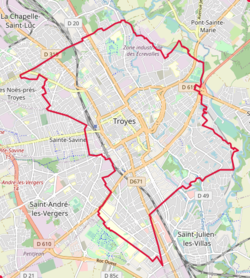
Back Troyes AF Troyes AN تروا Arabic تروا ARZ Troyes AST Труа BE Троа Bulgarian Troyes BM Troyes BR Troyes BUG
You can help expand this article with text translated from the corresponding article in French. (December 2008) Click [show] for important translation instructions.
|
Troyes | |
|---|---|
Prefecture and commune | |
 Buildings in the historic quarter of Troyes | |
 | |
| Coordinates: 48°17′59″N 4°04′45″E / 48.2997°N 4.0792°E | |
| Country | France |
| Region | Grand Est |
| Department | Aube |
| Arrondissement | Troyes |
| Canton | Troyes-1 Troyes-2 Troyes-3 Troyes-4 Troyes-5 |
| Intercommunality | CA Troyes Champagne Métropole |
| Government | |
| • Mayor (2020–2026) | François Baroin[1] (LR) |
Area 1 | 13.2 km2 (5.1 sq mi) |
| Population (2022)[2] | 62,443 |
| • Density | 4,700/km2 (12,000/sq mi) |
| Time zone | UTC+01:00 (CET) |
| • Summer (DST) | UTC+02:00 (CEST) |
| INSEE/Postal code | 10387 /10000 |
| Elevation | 100–126 m (328–413 ft) (avg. 118 m or 387 ft) |
| 1 French Land Register data, which excludes lakes, ponds, glaciers > 1 km2 (0.386 sq mi or 247 acres) and river estuaries. | |

Troyes (French pronunciation: [tʁwa] ⓘ) is a commune and the capital of the department of Aube in the Grand Est region of north-central France. It is located on the Seine river about 140 km (87 mi) south-east of Paris. Troyes is situated within the Champagne wine region and is near the Orient Forest Regional Natural Park.
Troyes had a population of 61,996 inhabitants in 2018. It is the center of the Communauté d'agglomération Troyes Champagne Métropole, which was home to 170,145 inhabitants.
Troyes developed as early as the Roman era, when it was known as Augustobona Tricassium. It stood at the hub of numerous highways, primarily the Via Agrippa. The city has a rich historical past, from the Tricasses tribe to the liberation of the city on 25 August 1944 during the Second World War, including the Battle of the Catalaunian Plains, the Council of Troyes, the marriage of Henry V and Catherine of France, and the Champagne fairs to which merchants came from all over Christendom. The city has a rich architectural and urban heritage: many buildings are protected as historical monuments, including the half-timbered houses (mainly of the 16th century) that survived in the old town. They have contributed to Troyes being designated as a City of Art and History.
Manufacturing of textiles, developed from the 18th century onwards, was a chief part of Troyes' economy until the 1960s. Today, Troyes is the European capital of factory outlets and trading, and has three brand centers.
- ^ "Répertoire national des élus: les maires" (in French). data.gouv.fr, Plateforme ouverte des données publiques françaises. 6 June 2023.
- ^ "Populations de référence 2022" (in French). The National Institute of Statistics and Economic Studies. 19 December 2024.




